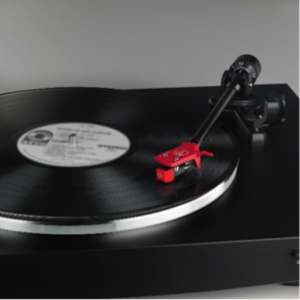Question: Why is my turntable so much quieter than my CD player?
Answer: Suppose you are hooking up your brand new Audio-Technica turntable to your home theater system. You have your TV, CD player, Blu-ray player and turntable all hooked up to the receiver, and notice after playing the turntable that it is playing the audio at a quieter volume level than you are normally used to. After playing the same song on the CD player, it definitely seems lower, and you are sure you have the phono preamp turned on inside the turntable.
Fear not! For this is completely normal when playing vinyl records. This is mainly due to the difference between mastering techniques used on analog recordings versus digital.

Because vinyl records are a physical medium of recorded audio waveforms, the record itself is going to have some natural limitations on how loud it can be pressed before the needle has difficulty tracking the record. With digital recordings, the maximum peak level is not as limited as on vinyl, and can be digitally encoded with the maximum peak amplitude. On top of this, mastering engineers will use a digital limiter to bring down peak levels before they happen and compressors to help reduce the louder peaks and raise lower volumes. This gives the mastering engineer more control of the overall volume of the track and allows them to raise the overall track volume (without exceeding 0 dB). Typically, the louder a song is played on the radio, the more likely it is to grab someone’s attention. This concept, often referred to as “The Loudness War,” is what has driven mastering engineers and record labels over the years to continually make recordings louder.
Just like anything competitive, there is always going to be the temptation to push boundaries and raise volume levels to extremes. However, the absolute limit is 0 dB. Pushing the volume level beyond 0 dB can create digital distortion, or what is often referred to as “clipping,” which is not enjoyable to listen to. The mastering process for vinyl records does not use nearly as much compression as a digital master, and is more focused on having a wider dynamic range at lower volumes. This can potentially make the record sound warmer, brighter, and more detailed than the same song on a CD.
The volume level of the record is not solely based on the mastering process itself, but also the output level of the cartridge being used on the turntable and the gain stage of the phono preamp. Typically, moving magnet cartridges are going to give you a louder output than moving coil cartridges, which generally have a much lower output. If you feel that the phono preamp you are currently using just isn’t quite loud enough, you could always try another one with higher gain. For the best recommendations, we suggest contacting one of our authorized dealers.
If you have any further questions about the volume level differences between vinyl and CD, please contact us here in the Audio Solutions Department.
















































































































































.webp)































